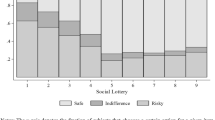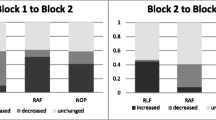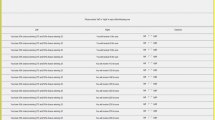Abstract
Many risky decisions generate either positive externalities (e.g., opening a small business, engaging in research and development, vaccinating) or negative externalities (e.g., smoking, reckless driving, unprotected sex). I develop a new experimental framework for evaluating risk tolerance when risky decisions that generate externalities by modifying the allocation task of Gneezy and Potters (1997). In the ‘risk with externalities’ framework, for each unit increase in a risky allocation, an external cost or benefit is imposed upon a group member. I further vary the magnitude of the external effect to investigate the sensitivity of risk taking to the marginal external effect. Results indicate that risky decisions are driven by a combination of social and non-social factors. When individuals both impose and receive externalities, the preferred level of risk taking is lower if the externality is negative, regardless of the magnitude of the marginal external effect. Risk taking is then further affected by the magnitude of the marginal external effect. For individuals who only impose externalities, behavior is consistent with a disutility from imposing harm (but not a sensitivity to the magnitude of the external effect). For those who only receive externalities, individuals increase (decrease) their risky allocation when they are in a decision environment where they receive external benefits (costs). Additional treatments suggest that results are consistent with decreasing relative risk aversion plus an additional disutility from either imposing or receiving harmful externalities.


Similar content being viewed by others
Notes
Of course, individuals may also deviate from this standard of ‘rationality’ by, for example, having time-inconsistent preferences (e.g., Gruber & Köszegi, 2001) or by any number of naturally occurring decision errors (e.g., Dörner & Schaub, 1994). My design abstracts away from these important, but separate, issues. This framework does not include delayed payoffs, asymmetric information, or a complex decision environment in order to clearly identify the social component.
For example, in linear public good environments, individuals tend to invest less in whichever account is risky: decreasing cooperating if the public account is risky and increasing cooperation if the private account is risky (see e.g., Artinger et al., 2012; Cherry et al., 2015; Levati & Morone, 2013; Gangadharan & Nemes, 2009), though not always (Stoddard, 2014). Wengström and Vesely (2017) find that if both accounts are risky it is easier to sustain cooperation. In threshold public goods, uncertainty regarding the return from the public good does not affect cooperation unless there is a possibility of loss (e.g., Kidwai & de Oliveira, 2017; McCarter et al., 2010; van Dijk et al., 1999).
I use the term ‘preference’ loosely here, referring to their revealed preference for a particular level of risk taking and not a parameter of an assumed utility function.
The multipliers include: ± 0.1, ± 0.25, ± 0.4, ± 0.5, ± 0.6, ± 0.75, ± 0.9, ± 1.0, 1.2, 1.5, 2.0, 3.0. The largest negative externality (100 E$) was set such that the subject could lose their entire show-up fee but not lose money out of their pocket.
While this may create a wealth or portfolio effect, these are common to all subjects and should not affect the differences across treatments.
In ARwE-I, 9 subjects always allocate the same amount. There are 8 subjects in ARwE-R and 4 in the NI-R treatment who do the same.
References
Acs, Z. J., Braunerhjelm, P., Audretsch, D. B., & Carlsson, B. (2009). The knowledge spillover theory of entrepreneurship. Small Business Economics, 32, 15–30.
Aflaki, S. (2013). The effect of environmental uncertainty on the tragedy of the commons. Games and Economic Behavior, 82, 240–253.
Andersson, O., Holm, H. J., Tyran, J. R., & Wengstrom, E. (2016). Deciding for others reduces loss aversion. Management Science, 62(1), 29–36.
Andreoni, J. (1990). Impure altruism and donations to public goods: A theory of warm glow giving. The Economic Journal, 100, 464–477.
Artinger, F., Fleischhut, N., Levati, M. V., & Stevens, J. R. (2012). Cooperation in risky environments: Decisions from experience in a stochastic social dilemma. Jena Economic Research Papers, 2012, 047.
Avery, C., Heymann, J., & Zeckhauser, R. (1995). Risks to selves, risks to others. American Economic Review, Papers and Proceedings, 61–66.
Balsa, A. I., Gandelman, N., & González, N. (2015). Peer effects in risk aversion. Risk Analysis, 35(1), 27–43.
Bartling, B., & von Siemens, F. A. (2010). The intensity of incentives in firms and markets: Moral hazard with envious agents. Labour Economics, 17(3), 598–607.
Becker, G. S., & Murphy, K. M. (1988). A theory of rational addiction. Journal of Political Economy, 96(4), 675–700.
Bolton, G. E., & Ockenfels, A. (2010). Betrayal aversion: Evidence from Brazil, China, Oman, Switzerland, Turkey, and the United States: Comment. American Economic Review, 100(1), 628–633.
Bolton, G. E., Ockenfels, A., & Stauf, J. (2015). Social responsibility promotes conservative risk behavior. European Economic Review, 74, 109–127.
Botelho, A., Dinar, A., Costa Pinto, L. M., & Rapoport, A. (2014). Time and uncertainty in resource dilemmas: Equilibrium solutions and experimental results. Experimental Economics, 17, 649–672.
Brennan, G., González, L. G., Werner Güth, W., & Levati, M. V. (2008). Attitudes toward private and collective risk in individual and strategic choice situations. Journal of Economic Behavior and Organization, 67(1), 253–262.
Brock, J. M., Lange, A., & Ozbay, E. Y. (2013). Dictating the risk: Experimental evidence on giving in risky environments. American Economic Review, 103(1), 415–437.
Cettolin, E., & Tausch, F. (2015). Risk taking and risk sharing: Does responsibility matter? Journal of Risk and Uncertainty, 50(3), 229–248.
Cettolin, E., Riedl, A., & Tran, G. (2017). Giving in the face of risk. Journal of Risk and Uncertainty, 55(2–3), 95–118.
Chakravarty, S., Harrison, G. W., Haruvy, E. E., & Ruström, E. E. (2011). Are you risk averse over other people’s money? Southern Economic Journal, 77(4), 901–913.
Charness, G. B., & Gneezy, U. (2012). Strong evidence for gender differences in risk taking. Journal of Economic Behavior and Organization, 83(1), 50–58.
Charness, G. B., Gneezy, U., & Imas, A. (2013). Experimental methods: Eliciting risk preferences. Journal of Economic Behavior and Organization, 87, 43–51.
Charness, G. B., & Jackson, M. O. (2009). The role of responsibility in strategic risk-taking. Journal of Economic Behavior and Organization, 69(3), 241–247.
Charness, G. B., & Rabin, M. (2002). Understanding social preferences with simple tests. Quarterly Journal of Economics, 117(3), 817–869.
Cherry, T., Howe, E. L., & Murphy, J. J. (2015). Sharing as risk pooling in a social dilemma experiment. Ecology and Society, 20(1), 68.
de Oliveira, A. C. M., Smith, A., & Spraggon, J. (2017). Reward the lucky? An experimental investigation of the impact of agency and luck on bonuses. Journal of Economic Psychology, 62, 87–97.
Dörner, D., & Schaub, H. (1994). Errors in planning and decision-making and the nature of human information processing. Applied Psychology, 43(4), 433–453.
Eckel, C., de Oliveira, A. C. M., & Grossman, P. J. (2008). Gender and negotiation in the small: Are women (perceived to be) more cooperative than men? The Negotiation Journal, 24(4), 429–445.
Eckel, C. C., & Grossman, P. J. (2008). Forecasting risk attitudes: An experimental study using actual and forecast gamble choices. Journal of Economic Behavior an Organization, 68(1), 1–17.
Eckel, C. C., & Grossman, P. J. (2002). Sex differences and statistical stereotyping in attitudes toward financial risk. Evolution and Human Behavior, 23(4), 281–295.
Engelmann, D., & Strobel, M. (2004). Inequality aversion, efficiency, and maximin preferences in simple distribution experiments. American Economic Review, 94(4), 857–869.
Eriksen, K., Kvaløy, O., & Luzuriaga, M. (2014). Risk-taking with other people’s money. Working Paper.
Exley, C. (2015). Excusing selfishness in charitable giving: The role of risk. Review of Economic Studies, 83(2), 587–628.
Fischbacher, U. (2007). z-Tree: Zurich toolbox for ready-made economic experiments. Experimental Economics, 10, 171–178.
Füllbrunn, S., & Luhan, W. J. (2015). Am I my peer’s keeper? Social responsibility in financial decision making. NiCE Working Paper 15–03.
Gangadharan, L., & Nemes, V. (2009). Experimental analysis of risk and uncertainty in provisioning private and public goods. Economic Inquiry, 47(1), 146–164.
Gneezy, U., & Potters, J. (1997). An experiment on risk taking and evaluation periods. Quarterly Journal of Economics, 111(2), 631–645.
Greiner, B. (2004). An online recruitment system for economic experiments. In Forschung und Wissenschaftliches Rechnen. Gesellschaft für wissenschaftliche Datenverarbeitung Bericht, Vol. 63, ed. Kurt Kremer and Volker Macho, 79–93. Göttingen, Germany: Gesellschaft für wissenschaftli¬ che Datenverarbeitung.
Gruber, J., & Köszegi, B. (2001). Is addiction ‘rational’? Theory and evidence. Quarterly Journal of Economics, 116(4), 1261–1303.
Güth, W., Levati, M. V., & Ploner, M. (2008). On the social dimension of time and risk preferences: An experimental study. Economic Inquiry, 46(2), 261–272.
Harrison, G. W., Lau, M. I., Rutström, E. E., & Tarazona-Gómez, M. (2013). Preferences over Social Risk. Oxford Economic Papers, 65(1), 25–46.
Humphrey, S. J., & Renner, E. (2011). The social costs of responsibility. CEDEX Discussion Paper No. 2011–02.
Kidwai, A. H., & de Oliveira, A. C. M. (2017). Uncertainty and intent in threshold public goods: An experimental investigation. Working paper.
Knaup, A. E. (2005). Survival and longevity in the business employment dynamics data. Monthly Labor Review, May. Bureau of Labor Statistics. http://www.bls.gov/opub/mlr/2005/05/ressum.pdf. Accessed 20 Jun 2012.
Lahno, A. M., & Serra-Garcia, M. (2015). Peer effects in risk taking: Envy or conformity? Journal of Risk and Uncertainty, 50(1), 73–95.
Levati, M. V., & Morone, A. (2013). Voluntary contributions with risky and uncertain marginal returns: The importance of parameter values. Journal of Public Economic Theory, 15(5), 736–744.
Li, Z., Rohde, K. I. M., & Wakker, P. P. (2017). Improving one’s choices by putting oneself in others’ shoes – An experimental analysis. Journal of Risk and Uncertainty, 54(1), 1–13.
Linde, J., & Sonnemans, J. (2012). Social comparison and risky choices. Journal of Risk and Uncertainty, 44(1), 45–72.
Max, W. (2001). The financial impact of smoking on health-related costs: A review of the literature. American Journal of Health Promotion, 15(5), 321–331.
McCarter, M. W., Rockmann, K. W., & Northcraft, G. B. (2010). Is it even worth it? The effect of loss prospects in the outcome distribution of a public goods dilemma. Organizational Behavior and Human Decision Processes, 111(1), 1–12.
Minniti, M. (2005). Entrepreneurship and network externalities. Journal of Economic Behavior and Organization, 57(1), 1–27.
Montinari, N., & Rancan, M. (2018). Risk taking on behalf of others: The role of social distance. Journal of Risk and Uncertainty, 57(1), 81–109.
Pahlke, J., Strasser, S., & Vieider, F. M. (2015). Responsibility effects in decision making under risk. Journal of Risk and Uncertainty, 51(2), 125–146.
Rohde, I. M. T., & Rohde., K. I. M. (2011). Risk attitudes in a social context. Journal of Risk and Uncertainty, 43(3), 205–225.
Rovira, J., Viscusi, W. K., Antoňanzas, F., Costa, J., Hart, W., & Carvalho, I. (2000). Smoking risks in Spain: Part II-perceptions of environmental tobacco smoke externalities. Journal of Risk and Uncertainty, 21(2–3), 187–212.
Schildberg-Hörisch, H. (2010). Is the veil of ignorance only a concept about risk? An experiment. Journal of Public Economics, 94(11–12), 1062–1066.
Smith, V. L., & Wilson, B. J. (2017). Sentiments, conduct, and trust in the laboratory. Social Philosophy and Policy, 34(1), 25–55.
Stoddard, B. V. (2014). Probabilistic production of a public good. Economics Bulletin, 34(4), 2427–2442.
Sutter, M. (2009). Individual behavior and group membership: Comment. American Economic Review, 99(5), 2247–2257.
Trautmann, S. T., & Vieider, F. M. (2012). Social influences on risk attitudes: Applications in economics. In: Handbook of risk theory. Springer Publishing, 575–600.
Uccello, C. E. (2006). Costs associated with secondhand smoke. American Academy of Actuaries. http://www.actuary.org/pdf/health/smoking_oct06.pdf. Accessed 20 Jun 2012.
van Dijk, E., Wilke, H., Wilke, M., & Metman, L. (1999). What information do we use in social dilemmas? Environmental uncertainty and the employment of coordination rules. Journal of Experimental Social Psychology, 35(2), 109–135.
Viscusi, W. K., Phillips, O. R., & Kroll, S. (2011). Risky investment decisions: How are individuals influences by their Groups? Journal of Risk and Uncertainty, 43(2), 81–106.
Wengström, E., & Vesely, S. (2017). Risk and cooperation: Experimental evidence from stochastic public good games. Lund University Department of Economics Working Paper Vol 2017 No. 3.
Zhang, H. (2019). Common fate vs. independent fate: The influence of risks on contribution to public goods. Journal of Economic Psychology, 70, 12–21.
Acknowledgements
Thanks to Abdul Kidwai, Irene Mussio, Rodolfo Mango, Matthew Denny, Lawrence DeGeest, Anthony Lorencette-Desouza, and Jose Garces Ceballos for assistance with running sessions. Helpful comments from editors and anonymous referees, my CeMENT team and mentors, Cary Deck, Sarah Jacobson, John Spraggon and participants at the Economic Science Association North American Regional Meetings, Southern Economic Association annual meetings, and the Biennial Conference on Social Dilemmas greatly contributed to the quality of the research. Funding was provided by a Faculty Research Grant/Healey Endowment Grant and an Interdisciplinary Scholars Institute ‘Value’ Fellowship at the University of Massachusetts Amherst. All work was approved by the UMass Amherst IRB # 2012-1400.
Author information
Authors and Affiliations
Corresponding author
Additional information
Publisher's Note
Springer Nature remains neutral with regard to jurisdictional claims in published maps and institutional affiliations.
Supplementary Information
Below is the link to the electronic supplementary material.
Rights and permissions
About this article
Cite this article
de Oliveira, A.C.M. When risky decisions generate externalities. J Risk Uncertain 63, 59–79 (2021). https://doi.org/10.1007/s11166-021-09357-6
Accepted:
Published:
Issue Date:
DOI: https://doi.org/10.1007/s11166-021-09357-6




